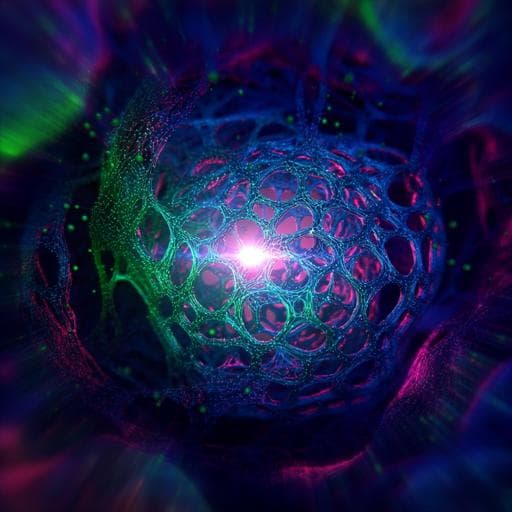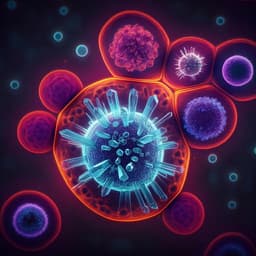
Engineering and Technology
Ultrafast 3D nanofabrication via digital holography
W. Ouyang, X. Xu, et al.
Discover a groundbreaking digital holography-based two-photon lithography platform that revolutionizes the parallel printing of complex 3D nanostructures with remarkable speed and precision. This innovative system achieves a staggering fabrication rate of 2,000,000 voxels/sec and promises to take TPL technology to new heights, validated by large-scale metastructures and optical devices. This cutting-edge research was conducted by Wenqi Ouyang, Xiayi Xu, Wanping Lu, Ni Zhao, Fei Han, and Shih-Chi Chen.
~3 min • Beginner • English
Introduction
The paper addresses the need for high-resolution, complex 3D nanostructures and the limitations of conventional two-photon lithography (TPL), which relies on serial point scanning and is too slow and costly for large-scale applications. Prior parallelization strategies (e.g., multi-beam interference, microlens arrays, diffractive optical elements) lack individual focus control and are generally restricted to periodic structures. Programmable beam shapers can enable individual control but are limited by device speed and insufficient laser power because two-photon polymerization (TPP) requires extremely high intensities. Femtosecond laser oscillators typically cannot support many foci (>50). Projection-based depth-resolved approaches avoid point scanning but are layer-by-layer and struggle with large overhangs without supports. Regenerative laser amplifiers offer orders-of-magnitude higher peak power but at low repetition rates (1–10 kHz), historically associated with higher polymerization thresholds, reduced dynamic range, and altered kinetics. The research question is whether a digital holography-based TPL system using a low-repetition-rate amplifier can deliver high-throughput, individually controllable multi-focus printing with sub-200 nm resolution and robust structural integrity, and how to manage the photopolymerization kinetics to achieve this.
Literature Review
The study situates itself among parallel TPL methods: multi-beam interference, microlens arrays, and diffractive optical elements generate multiple foci but lack individual control, limiting them to periodic patterns. Holographic and programmable beam shaping approaches (e.g., spatial light modulators, DMDs) enable dynamic control but previously suffered from limited pattern rates and small numbers of foci due to power constraints from oscillators. Projection-based TPL using depth-resolved light sheets offers high throughput but requires layer-by-layer processes that have difficulty with large overhangs. Prior work suggested low-repetition-rate amplifiers adversely affect TPP thresholds and kinetics, implying substantial changes would be needed in optics, photoresists, and parameters to maintain resolution and integrity. The authors build on holographic multi-focus control (WGS algorithm-based hologram synthesis) and two-photon absorber design to overcome these limitations, while addressing proximity and diffusion effects reported in multi-spot DLW literature.
Methodology
Optical system: A Ti:sapphire femtosecond regenerative amplifier (800 nm, 1 kHz, 100 fs, 4 W average power) provides ultrahigh peak power to support parallel writing. A digital micromirror device (DMD) displays weighted Gerchberg–Saxton (WGS)-synthesized holograms to generate up to 2000 individually controllable foci (amplitude, phase, position) at the Fourier plane after lens L3; a spatial filter blocks unused diffraction orders. To pre-compensate angular dispersion from the DMD, a reflective blazed grating (600 lines/mm) and a 4-f system (L1=225 mm, L2=250 mm) are placed before the DMD. A second 4-f relay (L4=200 mm) and the objective lens (L5, high-NA oil immersion) image the foci into the photoresist. Holograms are synchronized to 1 kHz laser pulses, enabling random-access 3D scanning at up to 2000 foci × 1000 Hz = 2,000,000 voxels/s. Work volume of a single DMD scan is 299 × 554 × 760 µm³; a six-axis hexapod stages the substrate for stitching larger parts.
Photoresist design: To suppress multiphoton ionization and promote two-photon absorption (2PA) under high peak intensities (3.3–22.7 TW/cm²), a bis-donor, symmetrically substituted conjugated 2PA initiator (~800 GM at 800 nm) is used, with a monomer base of BPADA (68 wt%) and PETA (32 wt%). The optimized formulation includes 0.4 wt% initiator and 70 ppm 4-hydroxyanisole (MEHQ) inhibitor. UV–vis spectra are provided in supplementary data. Raman spectroscopy tracks degree of crosslinking (DC) via peaks at 1589, 1630, and 1717 cm⁻¹.
Single-pulse exposure model: With 1 kHz repetition, exposure is delivered as single pulses per voxel, minimizing diffusion-driven voxel growth by keeping exposure intervals below diffusion times (~20 ms for PETA to diffuse 150 nm). The voxel size is governed by diffusion radius; single-pulse exposures avoid cumulative diffusion and overgrowth seen with many pulses per voxel. Experiments compare 1-, 20-, 100-, and 200-pulse exposures at equal total dose to validate the model.
Process workflow: Dip-in printing in liquid resist on FTO-coated glass; development in PGMEA (15 min) then IPA (10 min); air dry or freeze-dry (for fragile features) after water substitution. Proximity management avoids over-polymerization by ensuring nearest-neighbor foci are ≥3 µm apart. WGS holograms equalize intensity to ~99% uniformity; potential scaling to >4000 foci is discussed. Mechanical properties are characterized by rheometry (oscillatory time-sweep, compression, cyclic tests); SEM and optical microscopy are used for structural characterization; Raman confirms DC; magnetic actuation is performed with Helmholtz coils in aqueous PVP solution using Fe3O4 nanoparticle-doped resist.
Grayscale and device printing: Grayscale control achieved by encoding per-focus amplitude in holograms; demonstrated with 36 foci/11 grayscale levels and diffractive surfaces (1 × 4 cm² nano-dot arrays). Functional microgears are printed using a magnetic composite resist (3.0 wt% Fe3O4 nanoparticles).
Key Findings
- Throughput and resolution: Parallel holographic TPL with up to 2000 independently programmable foci achieves 2.0 × 10^6 voxels/s and 4.5–54.0 mm³/h volumetric rate for low filling ratios (1–12%). Achieved lateral and axial resolutions of 90 nm and 141 nm, respectively, using single-pulse exposures.
- Polymerization kinetics: Custom resist exhibits a single-pulse polymerization threshold of 1.27 nJ and a dynamic range of 12.46. Raman-derived DC increases from 16.2% to 48.5% as pulse energy rises from 1.37 to 6.85 nJ. Avalanche ionization signatures appear only above ~10 nJ (>25.9 TW/cm²), higher than typical printing energies (3–7 nJ), indicating multiphoton absorption dominates in single-pulse mode.
- Single vs. multi-pulse exposures: At equal dose, increasing pulses per voxel (20–200) causes tapered starts, surface roughening, and distortion due to cumulative diffusion and light deviations; single-pulse exposures yield smoother, finer features consistent with the diffusion-aware model.
- Multi-focus optimization: Over-polymerization in dense multi-focus patterns is eliminated by maintaining ≥3 µm spacing between active foci and using WGS for ~99% intensity uniformity. System potentially supports >4000 foci with some trade-offs.
- Energy efficiency: Average power requirements are 20–400 mW for 100–2000 foci, significantly lower than DOE-based (~4 W) and projection-based (~1.5 W) approaches, while providing superior resolution and flexible grayscale printing (>99% accuracy).
- Large metastructures: A 1.08 × 1.08 × 1 mm³ cubic metastructure (≈1.17 mm³) comprising 6.82 × 10^5 octahedral truss units (7.9 µm side, 700 nm linewidth) was printed with 100 foci. It withstands ~30% compressive strain and recovers upon unloading. Young’s moduli for two truss designs measured 35 MPa and 80 MPa; cyclic compression shows 20–30% mechanical resilience without fracture up to 85% strain. After carbonization at 900 °C (≈73% linear shrinkage), stiffness markedly increases (G' ≈ 22.7 kPa) and Young’s modulus reaches 497.3 MPa, near solid polymer values (~520 MPa).
- Complex devices and patterns: Demonstrated high-quality printing with 64–400 foci without quality degradation; 36-focus grayscale arrays with 11 levels fabricated in 150 ms; 1 × 4 cm² diffractive “CUHK” nano-dot arrays (4 µm period) produce mono/rainbow colors. 3D arrays include annular woodpile-derived units, egg-beater structures, and microlens arrays.
- Microrobotics: Magnetic micro-gears printed from composite resist (3.0 wt% Fe3O4) via 32 foci (500 nm voxel spacing); array printed in 49 s (≈290 ms per gear). Devices actuated in 10 mT fields achieve translation, rotation (5 Hz), and flipping (1 Hz).
Discussion
The results demonstrate that leveraging a low-repetition-rate amplifier with tailored photopolymerization kinetics and holographic multi-focus control breaks the traditional trade-off between resolution and throughput in TPL. Single-pulse exposures minimize diffusion-driven voxel growth, preserving sub-200 nm features while enabling MHz-range voxel rates through random-access, parallel scanning. The approach is particularly advantageous for low filling ratio architectures, avoiding wasted scanning over empty volume and achieving order-of-magnitude higher effective rates than inertia-limited systems. Compared to DOE and projection-based methods, the system offers superior resolution, energy efficiency, individual focus programmability, and accurate grayscale control, enabling complex, aperiodic structures, functional metastructures, and micromechanisms. Mechanical tests confirm reproducibility and resilience of large lattices, and post-fabrication carbonization broadens materials performance. Overall, the platform effectively scales TPL beyond prototyping towards practical, large-area manufacturing of functional micro/nanostructures.
Conclusion
A digital holography-enabled, multi-focus TPL platform using a 1 kHz femtosecond regenerative amplifier achieves up to 2000 individually programmable foci, 2 × 10^6 voxels/s, 4.5–54.0 mm³/h fabrication rates for sparse structures, and sub-200 nm resolution (90 nm lateral, 141 nm axial). A custom high-2PA photoresist and a single-pulse exposure strategy underpin low thresholds (1.27 nJ) and high dynamic range, while WGS-based holograms provide ~99% intensity uniformity and precise grayscale control (>99%). The method fabricates centimeter-scale diffractive surfaces, millimeter-scale metastructures with hundreds of thousands of units, and functional magnetic micromachines with high throughput. Future work could include scaling to >4000 foci with optical improvements (e.g., lower magnification objectives to expand work volume), further mitigating proximity effects, expanding material sets (e.g., functional composites), and integrating in-line metrology for closed-loop control to support industrial-scale nanomanufacturing.
Limitations
- Proximity effects: When many foci are close, over-polymerization or bulk solidification can occur due to spatial dose accumulation and diffusion; mitigated by maintaining ≥3 µm nearest-neighbor spacing and uniformizing intensities with WGS.
- Scaling trade-offs: Pushing beyond 2000–4000 foci can slightly compromise focus quality and intensity uniformity and increase proximity risks; larger field objectives can help at the cost of increased minimum step size.
- Work volume constraints: The DMD-scanner field (299 × 554 × 760 µm³) necessitates stitching for larger parts.
- Material constraints: Magnetic nanoparticle composites raise the writing threshold (~8.6×), which can limit throughput in conventional systems; while manageable here, material formulations still require optimization.
- Low-repetition-rate dynamics: The approach relies on single-pulse kinetics and custom photoresist; generalizability to other chemistries and feature sets may require further tuning of initiators, inhibitors, and exposure protocols.
Related Publications
Explore these studies to deepen your understanding of the subject.







